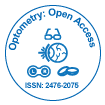Multimodal Ophthalmic Diagnostics: Advancing Eye Care Through Integrated Imaging
Received: 03-May-2025 / Manuscript No. omoa-25-171445 / Editor assigned: 05-May-2025 / PreQC No. omoa-25-171445 / Reviewed: 17-May-2025 / QC No. omoa-25-171445 / Revised: 23-May-2025 / Manuscript No. omoa-25-171445 / Published Date: 29-May-2025 DOI: 10.4172/2476-2075.1000318
Introduction
The field of ophthalmology has witnessed remarkable technological advancements over the past few decades. Traditional eye examinations, though essential, often rely on subjective assessments and limited imaging techniques. The emergence of multimodal ophthalmic diagnostics—the integration of multiple imaging and testing modalities—has transformed eye care by providing a comprehensive, objective, and precise evaluation of ocular health. This approach combines techniques such as optical coherence tomography (OCT), fundus photography, fluorescein angiography, and visual field testing, allowing clinicians to detect and monitor ocular diseases at earlier stages and with higher accuracy. Multimodal diagnostics not only enhance disease detection but also guide personalized treatment plans, improving patient outcomes [1-4].
Discussion
Optical coherence tomography (OCT) is a cornerstone of multimodal diagnostics. It generates high-resolution, cross-sectional images of retinal layers, enabling early detection of conditions such as age-related macular degeneration (AMD), diabetic retinopathy, and glaucoma. OCT angiography (OCTA), a newer variation, visualizes retinal and choroidal vasculature without the need for dye injection, reducing patient risk and discomfort. When combined with fundus photography, clinicians gain a comprehensive view of structural changes in the retina, allowing correlation between vascular anomalies and retinal morphology [5,6].
Fluorescein and indocyanine green angiography remain invaluable for evaluating retinal and choroidal circulation, particularly in complex vascular disorders. While these techniques are invasive, their integration with OCT and fundus imaging enhances diagnostic accuracy by providing both functional and structural information. Visual field testing complements imaging by assessing the functional impact of anatomical changes, crucial for glaucoma and optic neuropathies [7,8].
The true strength of multimodal diagnostics lies in the synergy of data integration. For instance, in diabetic retinopathy, combining OCT, fundus photography, and fluorescein angiography allows precise mapping of microaneurysms, macular edema, and neovascularization. Similarly, in AMD, integrating OCT with fundus autofluorescence helps differentiate between dry and wet forms, guiding therapeutic decisions such as anti-VEGF injections or laser therapy. Beyond diagnosis, multimodal approaches support longitudinal monitoring, enabling clinicians to evaluate disease progression, treatment efficacy, and potential complications over time [9,10].
Moreover, advancements in artificial intelligence (AI) and machine learning are amplifying the potential of multimodal diagnostics. AI algorithms can analyze complex datasets from multiple imaging sources to detect subtle abnormalities, predict disease progression, and suggest personalized interventions, thereby enhancing clinical decision-making and efficiency.
Conclusion
Multimodal ophthalmic diagnostics represent a paradigm shift in eye care, providing a holistic and precise assessment of ocular health. By integrating structural, vascular, and functional data, clinicians can detect diseases earlier, tailor interventions more effectively, and monitor outcomes with unprecedented accuracy. As imaging technologies continue to evolve and AI becomes further embedded in clinical workflows, the potential of multimodal diagnostics will expand, promising improved patient care and reduced vision loss worldwide. In essence, the convergence of diverse diagnostic modalities marks a new era in ophthalmology—one in which comprehensive, data-driven, and patient-centered eye care is not only possible but rapidly becoming standard practice.
References
- Cairns JE (1968)Trabeculectomy Preliminary report of a new method. Am J Ophthalmol 66: 673-679.
- Landers J, Martin K, Sarkies N, Bourne R, Watson P (2012) A twenty-year follow-up study of trabeculectomy: Risk factors and outcomes. Ophthalmology 119: 694-702.
- Lehmann OJ, Bunce C, Matheson MM, Maurino V, Khaw PT, et al. (2000) Risk factors for development of post-trabeculectomy endophthalmitis. Br J Ophthalmol 84: 1349-1353.
- Higashide T, Ohkubo S, Sugimoto Y, Kiuchi Y, Sugiyama K (2016) Persistent hypotony after trabeculectomy: Incidence and associated factors in the Collaborative Bleb-related Infection Incidence and Treatment Study. Jpn J Ophthalmol 60: 309-318.
- Gedde SJ, Herndon LW, Brandt JD, Budenz DL, Feuer WJ (2012) Tube Versus Trabeculectomy Study Group. Postoperative complications in the tube versus trabeculectomy (TVT) study during five years of follow-up. Am J Ophthalmol 153: 804-814.
- Nayak B, Gupta S, Kumar G, Dada T, Gupta V, et al. (2015) Socioeconomics of long-term glaucoma therapy in India. Indian J Ophthalmol 63: 20-24.
- Sihota R, Angmo D, Chandra A, Gupta V, Sharma A (2015) Evaluating the long-term efficacy of short-duration 0.1 mg/ml and 0.2 mg/ml MMC in primary trabeculectomy for primary adult glaucoma. Graefes Arch Clin Exp Ophthalmol 253: 1153-1159.
- Dada T, Kusumesh R, Bali SJ, Sharma S, Sobti A et al. (2013) Trabeculectomy with combined use of subconjunctival collagen implant and low-dose mitomycin C. J Glaucoma 22: 659-662.
- Vision A, Health E (2013) Prevalence and risk factors for myopia among school children in Aba, Nigeria. African Vis Eye Health 76: 1-5.
- Optometry C (2017) Prevalence and associated factors of myopia among high school students in Gondar town, northwest Ethiopia, 2016. Clin Optom 9: 11–18.
Citation: Aisha B (2025) Multimodal Ophthalmic Diagnostics: Advancing Eye Care Through Integrated Imaging. Optom Open Access 10: 318. DOI: 10.4172/2476-2075.1000318
Copyright: © 2025 Aisha B. This is an open-access article distributed under the terms of the Creative Commons Attribution License, which permits unrestricted use, distribution, and reproduction in any medium, provided the original author and source are credited.
Select your language of interest to view the total content in your interested language
Share This Article
Recommended Journals
Open Access Journals
Article Tools
Article Usage
- Total views: 153
- [From(publication date): 0-0 - Dec 22, 2025]
- Breakdown by view type
- HTML page views: 123
- PDF downloads: 30
